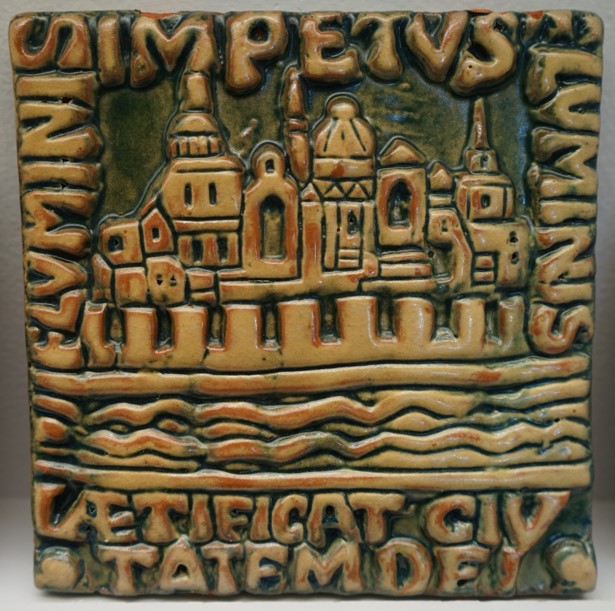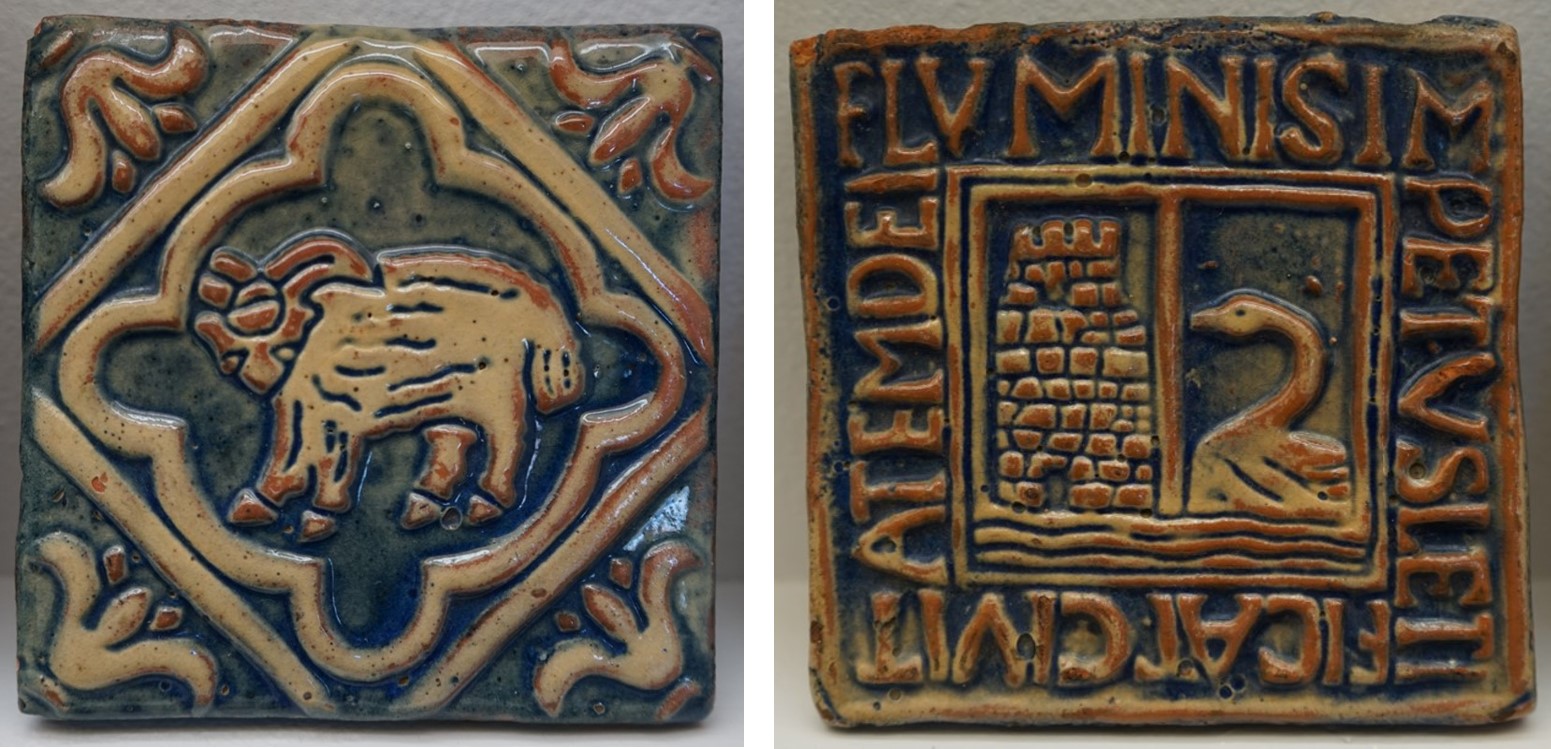Henry Chapman Mercer established Moravian Pottery and Tile Works in 1898 in Doylestown, Pennsylvania. Mercer originally studied to become a lawyer, but after completing school, chose to dedicate his life to his true interests: archaeology and anthropology. Mercer was an avid collector of artifacts, developing a love for ceramics and pottery tools, and was greatly inspired by the Pennsylvania Germans, also known as the Moravians, from whom he drew the name for his company. Production began at his family estate in 1899 and transferred to the factory in 1912. Mercer designed all of the tiles produced at Moravian Pottery, and subscribed to the tenets of the Arts and Crafts movement, believing that the use of machines to create pottery led to the loss of character and uniqueness.
Moravian Pottery produced four different types of tiles: quarry, mosaic, brocade, and decorative. The decorative tiles (examples of which are illustrated here) were created by pressing wet clay into one of two types of plaster molds, a press mold or a stamp mold. A press mold imprints a design on wet clay by being pressed down onto the clay, thus also determining the thickness of the tile, whereas a stamp mold creates an image in the wet clay by pushing the clay into the mold itself and trimming away the excess clay. Plaster molds allowed craftspeople to maintain the handmade quality of the tiles while producing multiples of the same design without the necessity of carving each individual tile by hand.

Once shaped, the tiles were completed with one of several different methods, many of which Mercer himself developed. Craftspeople finished the decorative tiles by painting on slip or underglazes and then using a cloth to wipe away some of the additional material, leaving the clay body visible on the raised areas of the design and the recessed areas colored. Moravian Pottery produced only eight glaze colors: blue, green, lilac, white, black, brown, and two variations of yellow. Two variations of a clear glaze were also used, one which merely coated the tile and its underlying colors, and one that contained high levels of red lead which altered the colors beneath.

There are several Moravian Pottery decorative tiles in the Everson’s collection, five of which are currently on display in the exhibition The Art of the Tile. Two of the tiles, one depicting a swan and tower and one a rendering of the ancient city of Jerusalem, were made in the early twentieth century, likely with the production methods described above under Mercer’s supervision. Each is inscribed with phrases around their borders that address the scene in the tile’s center. The Jerusalem tile’s Latin inscription, “luminis impetus luminis” and “laetificat cui tatem dei” translates to “the streams of light” and “to whom he rejoiceth: but the glory of God.” Another tile in the exhibition, although made much later, shares the same compositional elements and production methods as the earlier tiles. Known as the Peaceable Kingdom tile, this work was designed for the Everson by local potter Cleota Gabriel in 1977 as part of a fundraiser for the Museum to purchase The Peaceable Kingdom by Edward Hicks. Gabriel developed five designs inspired by Hicks’s painting, and Moravian Pottery produced the tiles in an edition of 2500.
After Mercer’s death in 1930, ownership of Moravian Pottery transferred to his friend and business partner Frank Swain, changing hands several more times before being purchased in 1968 by the Bucks County Department of Parks and Recreation. In 1969, the site opened to the public as a museum, and after several years of research and testing, Moravian Pottery and Tile Works resumed production of ceramics in 1976. Today, the site operates as a working history museum and continues to produce Mercer’s original designs.
The Art of the Tile is on view through December 31, 2018. After exploring this exhibition, visit the Museum’s upper galleries to see Visions of America, where Hicks’s Peaceable Kingdom is on display.
-Sidney Duncan, Curatorial Intern and Steffi Chappell, Curatorial Assistant
Image captions:
- Top left: Moravian Pottery and Tile Works, Aries Tile, 1913, earthenware, 4 x 4 inches, Everson Museum of Art, Museum purchase, 86.20.3
- Top right: Moravian Pottery and Tile Works, Swan and Tower Tile, 1901, earthenware, 3¾ x 3¾ inches, Everson Museum of Art, Museum purchase, 86.20.5
- Middle: Moravian Pottery and Tile Works, City of God Tile, 1913, earthenware, 5½ x 5½ inches, Everson Museum of Art, Museum purchase, 86.20.4
- Bottom: Moravian Pottery and Tile Works, Peaceable Kingdom Tile, 1977, earthenware, 4½ x 4½ inches, Everson Museum of Art, Museum purchase, 78.19.2



